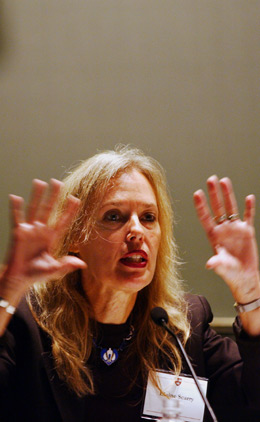Defining art: TV or not TV?

What distinguishes Superman from “Man and Superman,” “Rock Around the Clock” from Rachmaninoff, “Jurassic Park” from “Mansfield Park”?
It may be easy to tell great art from popular art, but being able to articulate why one is of lasting value and the other of lesser consideration is a question that has challenged even the most perceptive critics.
And beyond that question lie further puzzles: What is the relationship between “serious” art and popular art? Do popular venues like television threaten traditional forms like live theater, or do they nurture one another? Should serious art be subsidized or should it be left to sink or swim in the market as popular art is?
Six scholars representing six different fields of artistic endeavor attempted to shed light on these questions at an inaugural symposium on Oct. 12. They may not have reached any definite conclusions, but they did manage to push the debate in some interesting directions and to leave some intriguing questions in the minds of the audience.
Elaine Scarry, the Walter M. Cabot Professor of Aesthetics and the General Theory of Value and a member of the Department of English and American Literature, served as moderator. She began the discussion by asking Robert Brustein, the artistic director of the American Repertory Theatre, to discuss his views on the relationship between high and low art.
Brustein said that he saw no real conflict between serious art and popular entertainment, at least as far as the theater is concerned. In fact, he pointed out, in the earliest example of Western theater, that of ancient Greece, both tragedy and bawdy satirical comedy were performed as part of religious ceremonies. Nor was there any discontinuity between dramatic presentations and popular entertainment in Shakespeare’s time. The split between the two realms has only come about relatively recently.
Nevertheless, he said, “the greatest artists have always incorporated the energies of popular culture in their works.”
The danger to serious art, as Brustein sees it, comes not from popular culture, but from what he called “the three horsemen of anti-culture.”
Coming from the right is the “horseman of moral correctness,” which is quick to label any art that does not conform to traditional standards as “blasphemous, ugly, and obscene.”
From the left comes the “horseman of political correctness,” advocating multiculturalism and diversity – laudable in its aims, but often lapsing into a denigration of Western culture as elitist and male-centered.
Finally, there is the middlebrow “third horseman of aesthetic correctness,” ready to condemn anything not accessible to the middle-class public.
This attack on culture is reflected in the decline of the National Endowment for the Arts, “which has virtually disappeared as an institution with any influence in our lives,” Brustein said.
K. Anthony Appiah, the Charles H. Carswell Professor of Afro-American Studies and of Philosophy, saw little conflict between the entertaining and enduring. “Some of the most artistic works continue to be entertaining,” he said.
Appiah said that while the schools of modern art and art for art’s sake have often led to works notable for their obscurity, universities have performed a significant service by familiarizing a greater number of people with the strategies and modes of expression of difficult modern art.
“Universities have created a larger educated public so that more people are able to have James Joyce by their bedside as part of their cultural life and are able to enrich their lives with more demanding art.”
James Cuno, the Elizabeth and John Moors Cabot Director of the Harvard University Art Museums, dealt with the question of enduring art versus mass culture from the point of view of a museum director.
“The relationship between the enduring and the entertaining is a complicated one, but it seems clear that each depends on the other,” he said.
Cuno said that it was encouraging that museums have been enormously popular in recent years, claiming more visitors than all sports events combined. And yet, he wondered whether courting popularity with blockbuster shows would necessarily benefit museums in the long run.
Most disturbing, Cuno said, is a recent partnership between the Guggenheim Museum and a Las Vegas casino to present a show of paintings sponsored by BMW. Cuno worried that the Guggenheim was turning itself into “just another high-end brand name.”
Kay Shelemay, the G. Gordon Watts Professor of Music, presented a musical recording to illustrate her point that serious and enduring forms of art can often coexist, even blend, with popular forms. The example she played was a sacred song performed by Jews from Syria. The text was biblical Hebrew but the melody had been borrowed from a popular Arabic song commonly heard in the streets and coffeehouses of Aleppo.
“This is a musical union that goes beyond simple borrowing. The borrowed tune is rendered sacred by its association with the sacred text,” she said.
Moshe Safdie, director of urban design and the Ian Woodner Professor of Architecture and Urban Design at the Graduate School of Design from 1978 to 1993, said that it is difficult to think of high and low culture in architecture given that almost any building project requires enormous resources in order to be constructed.
Still, a split exists between the ideas of avant-garde designers and the taste of the general public. Safdie told a story from his own practice to illustrate the significance of this split.
Safdie’s firm won a competition to design a new public library for the city of Vancouver. The winner was determined by a vote by the general public and by a professional jury. In this case, both groups voted for Safdie’s design. “But what would have happened,” he wondered, “if the vote had been split?” Which group would have prevailed?
“The question is, what weight to give to the opinion of the experts and what weight to give to the voice of the public? I tend to err on the side of the public,” he said.
Contact Ken Gewertz at ken_gewertz@harvard.edu




